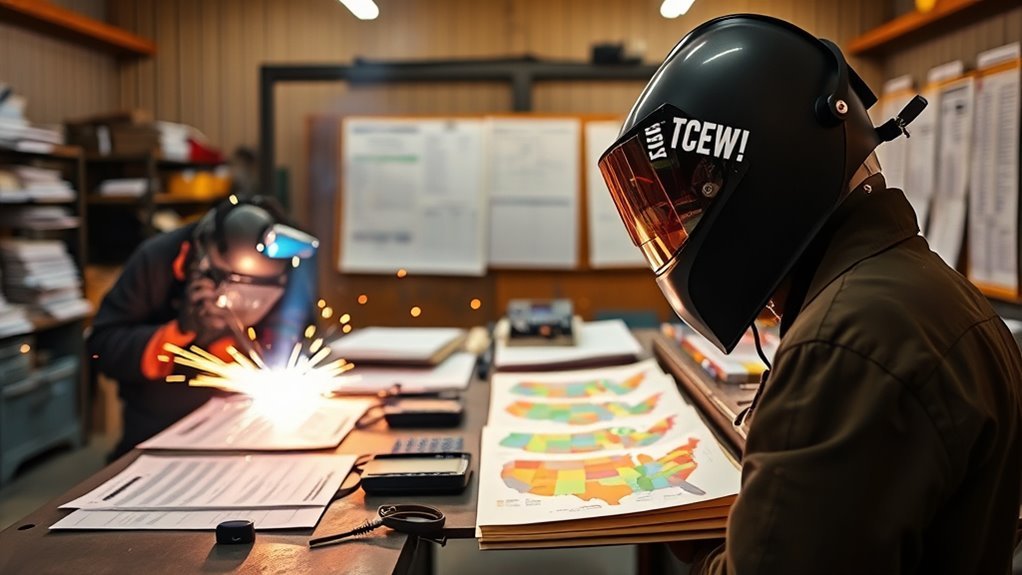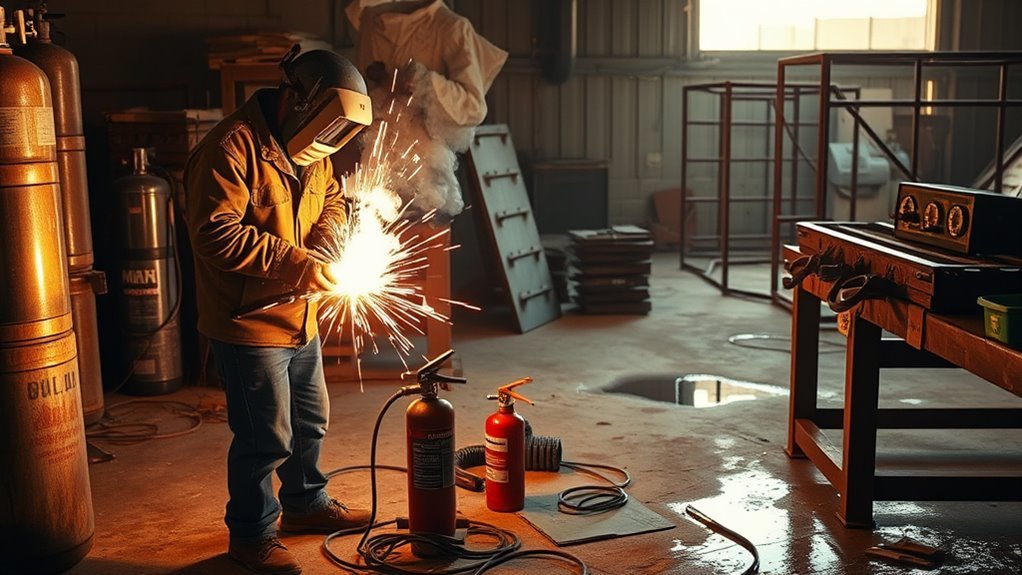Like a spark that can start a fire, your welding work carries hidden liabilities you’ll want covered. You’ll want clear answers about typical monthly and annual premiums, what general liability and workers’ comp usually cover, and which risk factors drive costs up. Knowing bundling options and state differences helps you pick the right limits and lower rates, so keep going to see practical steps for getting accurate quotes and smart coverage.
What Liability Insurance Covers for Welding Contractors

Because welding work creates fire, burn and trip hazards, liability insurance for welding contractors covers the costs you’d face if your work injures someone or damages property—typically bodily injury and property damage arising from welding activities.
You need coverage for welding accidents such as fires started by sparks or injuries from trips over tools on site; a standard policy usually offers $1 million per-claim limits, adjustable to match project scale.
Insurance benefits pay claims, legal defense, and settlements that would otherwise come out of your pocket, and they can be required for state licensing.
Your premium depends on project types, business size, and chosen limits, so you’ll balance risk exposure against cost.
Analytically assess your typical jobs and liabilities, then select limits that cover plausible worst-case incidents without overinsuring minor operations.
Doing so gives you financial protection and regulatory compliance while keeping premiums aligned with operational reality.
Average Cost of General Liability for Welders

You can expect typical general liability rates for welders to run around $123 per month, or roughly $1,479 a year, though some states like New York push averages higher toward $193 monthly.
Annual premiums usually fall within that mid four-figure range, influenced by coverage limits (commonly $1M/$2M), business size, and claims history.
Bundling policies and your geographic location can meaningfully lower or raise those costs.
Typical Monthly Rates
Most welders pay somewhere between $90 and $193 per month for general liability coverage, with the national averages clustering around $123 monthly (about $1,479 annually) for many workers and $166 monthly across all states.
You’ll typically see solo welders pay $90–$115 monthly, depending on project risk, coverage limits, and adherence to welding safety practices that reduce insurance claims.
Businesses with two employees usually face higher rates because coverage must address bodily injury, property damage, and even lawsuit exposure like copyright claims.
Geographic variance matters: Maine averages about $144, New York about $193.
When evaluating quotes, compare limits, exclusions, and how factors — size, foot traffic, subcontractor use, and project risk level — shift monthly premiums.
Annual Premium Range
Having looked at typical monthly rates, it’s helpful to frame those figures as annual premiums to compare policies and budget accurately.
You can expect an annual premium for general liability as a welder to fall roughly between $899 and $2,900. Solo operators paying $90–$115 per month are seeing annual premiums near the lower end of that range.
When you do an insurance comparison, focus on coverage limits — a standard $1 million per-claim limit is common; higher limits raise premiums.
Also compare quoted annual premiums against what monthly billing would total to spot fees or savings.
- Typical annual premium range: $899–$2,900
- Solo monthly → annual: $90–$115 ×12
- Standard limit: $1M per claim
- Use insurance comparison to confirm value
Cost Influencing Factors
Because several variables affect rates, expect the average general liability premium for welders to hover near $123 per month ($1,479 annually) while individual quotes can move substantially higher or lower depending on business size, coverage limits, claims history, and geography.
You’ll pay less if you’re a solo welder doing low-risk projects — typical small-shop premiums run $90–$115 monthly — and more for larger crews or high-risk contracts.
Geography matters: state-level averages range roughly from $144 in Maine to $193 in New York, reflecting local loss costs and legal environments.
Insurers assess project types, safety controls, and prior losses; a clean claims history reduces rates, while frequent or severe claims push premiums up.
Adjusting coverage limits directly changes your premium.
Workers’ Compensation Costs and What Affects Them

While you’re budgeting for liability insurance, don’t overlook workers’ compensation, which for welders typically runs from about $2,450 to $7,000 per year (roughly $254 a month on average).
You need to understand what drives that cost so you can control it. Insurers charge roughly $7–$18 per $100 of payroll, so payroll size directly scales premiums.
State rules and local claim frequency shift rates: higher state claim rates mean higher costs. Your workforce size and the specific welding tasks affect your classification and rate.
Most importantly, your safety history matters — consistent safety training and proactive claim management lower loss experience and can yield premium discounts.
A strong safety record — ongoing training and proactive claim management — cuts losses and secures premium discounts.
- Payroll size: larger payrolls raise base premiums.
- Job classification: riskier welding tasks increase rates.
- State environment: jurisdictional claim trends alter costs.
- Safety record: training and claim management reduce premiums.
Focus on measurable controls to reduce your workers’ comp expense.
Bundling Options: BOPs, Professional Liability, and Umbrella Policies

When you bundle a BOP with general liability and property coverage, you’ll usually see monthly savings and up to a 10% discount that trims overall premiums.
Adding professional liability for about $74/month protects you from negligence or error claims that a BOP won’t cover.
If you expect large judgments, an umbrella policy — roughly $81/month — raises your liability limits to shield your business beyond primary policy caps.
BOP Savings Explained
If you bundle a Business Owners Policy (BOP) with professional liability and an umbrella policy, you can cut overall insurance costs by up to about 10% while gaining broader protection tailored to welding operations.
You’ll see BOP benefits clearly: combined general liability and commercial property coverage replaces separate purchases at lower rates. With an average BOP cost near $98 monthly, bundling reduces that figure when combined with professional liability (~$74/month) and an umbrella (~$81/month).
Bundling advantages include consolidated billing, simplified claims handling, and predictable budgeting.
- Lower combined premium compared to separate policies
- Broader coverage scope for shop and jobsite exposures
- Easier administration and fewer gaps in protection
- Improved risk management through coordinated limits
Professional Liability Benefits
Because bundling a BOP with professional liability and an umbrella policy cuts overlap and fills gaps, you’ll get clearer, more cost-effective protection for welding operations.
You’ll see professional liability specifically covers negligence or errors tied to your welding services — typically around $74/month — addressing exposures a BOP won’t. Coverage advantages include targeted defense and settlement funds for workmanship claims, reduced premium duplication when combined with a BOP (often up to 10% savings), and simplified policy management.
When you add workers’ compensation into the bundle, the combined average runs about $438/month ($5,257/year), which spreads risk and cost.
This analytical approach gives you predictable budgeting, minimized uninsured gaps, and stronger contractual credibility with clients.
Umbrella Limit Increases
Although a standard BOP and professional liability policy cover most routine welding risks, you’ll want an umbrella policy to raise limits quickly and affordably when larger claims arise.
You’ll see umbrella coverage benefits when a catastrophic claim exceeds your BOP or professional limits; an umbrella fills gaps and provides liability limits expansion without buying substantially higher primary limits.
Bundling reduces total cost—BOP ~$98, professional liability ~$74, umbrella ~$81 monthly—and can save up to 10% on combined premiums.
For many welding businesses the recommended bundle (BOP, workers’ comp, professional) averages $438 monthly; adding an umbrella often increases protection at modest incremental cost.
- Pay modestly for large-limit protection
- Extend primary policy limits instantly
- Cover catastrophic third-party claims
- Achieve savings via bundling
State-by-State Variations in Liability Premiums

When you compare rates across the country, you’ll see that general liability premiums for welding businesses vary noticeably—from a national average of about $166 per month to state lows around $144 in Maine and highs near $193 in New York.
You should use state regulations and premium comparisons to understand why those numbers differ: local rules, fee structures, and enforcement intensity change insurer exposure and pricing.
Look at each state’s claims history and market—higher frequency or severity of claims typically pushes premiums up, while fewer claims can pull them down.
Geographic differences in job availability and risk exposure also shape rates; urban centers with dense construction activity can cost more than rural areas.
You’ll benefit by comparing quotes from multiple carriers in your state and neighboring ones when feasible.
Focus on carriers that understand welding exposures and can align coverage limits to your operations, since tailoring coverage often yields better pricing than one-size-fits-all policies.
Common Risk Factors That Drive Up Insurance Rates

If your welding work involves heavy machinery, hazardous materials, or projects with public access, insurers will view you as higher risk and raise premiums accordingly. You should expect underwriters to scrutinize job types, location, workforce size, and claims history during their risk assessment. These factors shape perceived exposure and bargaining power during insurance negotiations.
- Claims history — frequent or large past claims signal higher future cost and push rates up.
- Project exposure — work for high-profile clients or on public sites increases potential liability limits.
- Geography and regulation — states with stricter rules or higher loss trends produce higher base rates.
- Workforce and payroll — more employees raise workers’ comp exposure, increasing total premium.
Be prepared to document safety programs and incident trends; clear records influence risk assessment and give you better footing in insurance negotiations, even though they won’t eliminate higher costs tied to inherently risky work.
Ways to Lower Your Welding Liability Insurance Premiums

Because insurers reward lower risk, you can cut your welding liability premiums by bundling policies, raising deductibles, and proving strong safety practices. You’ll often save up to 10% by bundling general liability and workers’ comp. Use deductible strategies to lower monthly costs, but plan for higher out‑of‑pocket exposure if a claim occurs. Focus on safety incentives: document training, inspections, and incident reductions to qualify for discounts.
| Action | Benefit | Implementation |
|---|---|---|
| Bundle policies | ~10% savings | Combine liability + workers’ comp |
| Raise deductible | Lower premiums | Calculate worst‑case cash flow |
| Safety program | Premium discounts | Training, PPE, inspections |
| Review coverage | Avoid overpaying | Update for workforce/operations |
Be analytical: quantify expected savings, model deductible trade‑offs, and track safety metrics. Don’t neglect periodic reviews and comparisons to guarantee savings persist as your operation changes.
How to Get Quotes and Choose the Right Coverage

You’ve tightened up safety, bundled policies, and adjusted deductibles — now it’s time to shop for coverage that matches the risk profile you’ve shaped.
Use online insurance comparison tools to gather multiple quotes quickly, then compare cost, limits, and exclusions. Remember average general liability costs—about $123/month or $1,479 annually—as a benchmark, but adjust expectations for project complexity and business size.
Conduct a thorough coverage assessment focused on welding-specific exposures; higher-risk jobs raise premiums and may require endorsements.
- Request quotes from at least three insurers via online platforms and brokers.
- Compare premiums against the $123/month average and note variations by risk.
- Evaluate bundled policy discounts (workers’ comp, commercial auto) to lower total cost.
- Schedule annual reviews to re-run insurance comparison and update your coverage assessment.
Make decisions based on quantitative comparisons and documented risk analyses to guarantee you’re neither underinsured nor overpaying.
Frequently Asked Questions
Do I Need Liability Insurance for Occasional Side Jobs?
Yes — you should carry liability insurance for occasional side jobs if you want protection; frequent side jobs increase risk, so evaluate insurance necessity, compare policies, and pick coverage that matches potential claims, clients, and contract requirements.
Does Liability Insurance Cover Subcontractors I Hire?
Like a safety net, you usually won’t be covered for subcontractor work unless your policy explicitly includes subcontractor coverage; check for liability exclusions, contract requirements, and insist on certificates of insurance from hired subs.
Are Damaged Tools and Equipment Covered by Liability Policies?
No — general liability typically won’t cover your damaged tools and equipment; you’ll need equipment coverage or tools protection like a inland marine or equipment floater policy to insure repair or replacement costs and downtime.
How Quickly Do Claims Affect My Future Premiums?
Claims usually affect your premiums within one renewal cycle; during the claims process insurers analyze liability severity, then apply premium adjustments based on frequency, severity, and underwriting; you’ll see changes at renewal or after major settlements.
Can I Get Insurance for Mobile Welding Operations?
Yes — you can get mobile welding coverage for on-site work. You’ll review insurance policy options covering general liability, auto, equipment, and pollution; insurers’ll assess operations, safety, and limits to price tailored premiums.
Conclusion
You’re not just buying insurance — you’re buying the calm to sleep through a project that could otherwise implode in a single spark. While costs typically sit between about $899 and $2,900 a year, your actual premium will fluctuate wildly with size, location, and claims history. Be analytical: compare BOPs, workers’ comp, and umbrella options, shop multiple carriers, and use safety practices to shrink rates until they barely register on your profit-and-loss.


